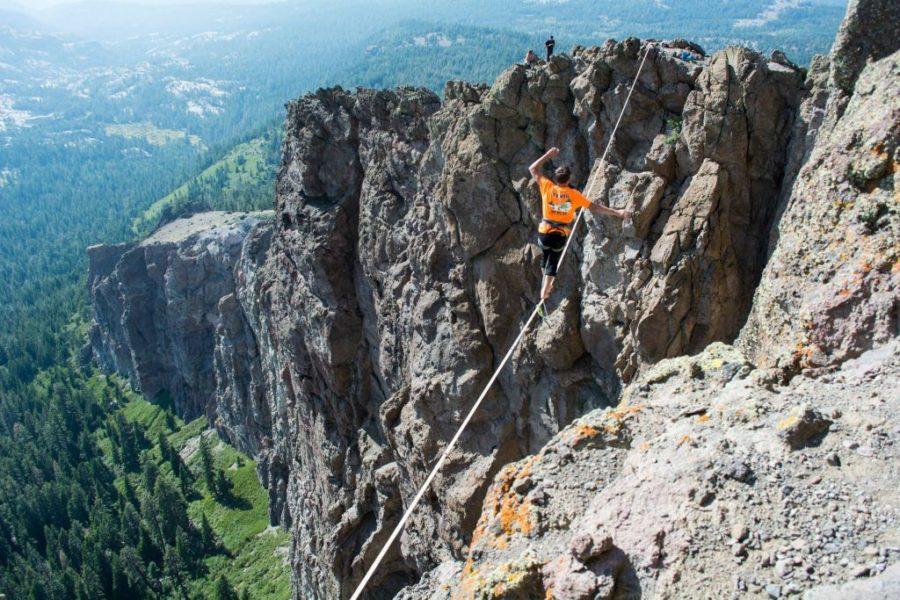Highlining and high living: Outdoor adventures
Courtesy of UnderTheBaseBoardLuke Gary highlining 700 feet off the ground, near Thunder mountain, south of Lake Tahoe. Picture from Gary’s personal collection.
December 1, 2015
Looking over the Yosemite skyline is breathtaking without a doubt, but picture walking over it, with nothing underneath but a rope and trees hundreds of feet tall.
To third-year business major Nick Nelson and senior business major Luke Gary, it is more than a possibility; highlining over the valley is what these guys do for fun.
While others look up to the trees and the mountains from the foot of the Yosemite valley, Nelson and Gary prefer to look at the trees and the mountains from a closer setting.
“The definition is where basically if you fall you can die,” said Gary. “But we wear harnesses.”
Nelson and Gary got an early start on their highlining skills. Gary started perfecting his highlining skills in high school, practicing from lower elevations before transitioning to higher and more advanced elevations.
Nelson’s specialty, on the other hand, is not highlining but rather rock climbing. Nelson manages to work at the rock climbing center in the WELL, go to school and go on rock climbing trips every two to three weeks.
After Nelson and Gary became friends, they began bonding over nature and their passion for nature photography.
“We started climbing at the same time, we met people as we went, but there’s not many people that do this,” said Gary.
Nelson, Gary and a few other of their friends climb up mountains, hills, and hiking trails in search for the perfect highline crossover. Together they enjoy the view, take pictures of their adventures and encourage others to get out and try something new as well, even if it is not highlining.
Nelson handles the rock climbing aspect of the trip while Gary handles the highlining part. The group carries almost 300 pounds of equipment, including ropes which can range from few hundred feet to a mile long.
“The best part is the momentarily isolation part of it, the only thing you’re thinking about is your next step,” Nelson said. “You get to see nature and think, ‘I hope this stays for many many more years.'”
The highlining ropes, some of the heaviest equipment pieces, are especially difficult to work with. The guys have to climb up, back down and up again, sometimes even crossing streams of water to get to the other side and harness the rope there.
“Humans are not really designed [for] being in exposed situations, especially way up off the ground with just air around you,” Gary said. “It’s just not where our minds were meant to be, so your body kinda freaks out and you hyperventilate and your peripheral vision starts shutting down and you start to get tunnel vision.”
Although highlining seems dangerous, it is actually quite protected. The highliners are tied onto two ropes: the one they are walking on and an extra back-up rope that goes around their waist. If the highliners are feeling off balance, they can just reach down and grab onto the rope they are on.
Both Nelson and Gary take turns as photographers while on their hikes. These photographs eventually make it onto social media like Instagram and Facebook, but where these guys want people to look at their work the most is on Nelson’s website.
The website, underthebaseboards.com, was created by Nelson after a friend gave him the idea to create a site where people could write and show others their adventures and passions. Since then, the website has evolved into a small-scale company.
Nelson thought of the idea for the name of the website when he was in church, as he heard the analogy comparing someone’s life being like a house.
“A lot of people, the last place [in a house] they will show you is under the baseboards,” Nelson said. “They’ll show you the living room where people have the stuff they want to show off before they show you the basement where their actual passions are.”
When first entering the website, the header reads “Live life. Don’t just Exist,” a philosophy Nelson lives by, which is especially prominent in his storytelling.
“Nick goes around and finds cool people and asks them if they can write their story He found me and asked me if I could write for [the website] too,” said Gary. Nelson then gives a prompt as a sort of guideline. The website is sort of like a blog, Nelson says.
Nelson’s ultimate goal is to be able to help finance his friends goals, whether through helping them buy a new guitar string or pay for a college class.
“What I want to do for the company is some how make enough money to support my friends and their passions,” said Nelson.
To help his friends and ultimately keep the website running, Nelson has created stickers showcasing Gary’s photographs and the website name. The stickers will be 99 cents and will available for purchase online this week. Nelson will also start printing out shirts and selling them in the coming months.






























































































































